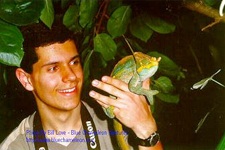



Review: The Panther Chameleon
By Christopher V. Anderson
Citation:
Anderson, C.v. (2004). Review: The Panther Chameleon. Chameleons! Online E-Zine, May 2004. (http://www.chameleonnews.com/04MayAndersonPantherBook.html)

The Panther Chameleon: Color Variation, Natural History, Conservation, and Captive Management
By: Gary W. Ferguson, James B. Murphy, Jean-Baptiste Ramanamanjato, Achille P. Raselimanana
Hardcover: 118 pages; .50" x 9.00" x 6.00"
Published By: Krieger Publishing Company, Copyright 2004
ISBN # 1-57524-194-3
List Price: $35.50
For this book on Furcifer pardalis, senior author Gary Ferguson, of Texas Christian University, collaborated with James Murphy, of Washington DC's National Zoological Park, and Malagasy scientists Jean-Baptiste Ramanamanjato and Achille Raselimanana to present the most complete work to-date on this species. Gary Ferguson is well known in the chameleon community for, among other things, his work with F. pardalis nutrition as well as having collaborated on the taxonomic description of Chamaeleo (Trioceros) jacksonii xantholophus. James Murphy was previously Dallas Zoo's Curator of Herpetology and more recently serves on the IUCN/SSC Declining Amphibian Populations Task Force board. Completing the picture, Malagasy natives Jean-Baptiste Ramanamanjato and Achille Raselimanana are Biodiversity Officers for QIT-Madagascar Minerals and the WWF, respectfully, in Madagascar.
As the title would imply, this book includes a wide array of topics relating to this species both in a wild and captivity setting. The content of the book has a clear scientific structure reflective of the authors' backgrounds. While some readers might find this scientific layout to be a turnoff, with it's a lack of photographs spread throughout the text and often complicated explanations, the book is very rich in useful information and 69 color photographs are included in the center plates section. These photographs include depictions of data collection methods for the section on color variation as well as of many panther locales and natural habitats.
The emergence of the first standardized and quantitative analysis of geographic locale variation is of particular significance. While it is by no means the final report on this topic, the methods by which the data has been collected and the findings themselves are of particular interest to evolutionary biologists, conservationist, breeders and hobbyists alike. It serves to create a standard by which further, more in depth and comprehensive studies can be completed with larger samples and more surveyed locales. Their thoughts on potential speciation and relatedness of locales are particularly thought provoking and their descriptions of locale variations using quantitative data should prove highly informative to chameleon enthusiast. Similarly, their views on conservation, trade collection, interbreeding and demography are particularly fascinating. The theories and methodologies discussed in these sections are very enlightening and stimulating.
Further informative aspects are the authors' nutritional comments, particularly in regard to UV-B light exposure and vitamin A, vitamin D and calcium requirements. The data and recommendations are directly related to topics of particular concern to hobbyists and breeders and have been anxiously awaited for some time. At the same time, there is a sense that these sections are perhaps too brief considering the years of research and the extent of published data the senior author has had with these very topics. Further attention and more in depth discussion would more than likely been welcomed by the chameleon community.
In addition to the more scientific and theory based chapters of the book, the authors present a section on captive management and husbandry. Much of their described approach to captive management is very informative but could be regarded as highly clinical and not necessarily appropriate for general care techniques outside of a lab situation.
Overall, Ferguson et. al. have presented the chameleon community with an excellent book containing a high level of scientific information and theory. Much of the information presented in the text has significance in multiple settings and is a superb addition to any chameleon enthusiast's book collection.
If you are interested in purchasing this book it is available through:
Amazon.com at: www.amazon.com
For: $35.50 ea. Plus shipping & handling.

Christopher V. Anderson

Chris Anderson is a herpetologist currently working on his Ph.D. at the University of South Florida after receiving his B.S. from Cornell University. He has spent time in the jungles of South East Asia, among other areas, aiding in research for publication. He has previously traveled throughout Madagascar in search of, and conducting personal research on, the chameleons of the region. He has traveled to over 35 countries, including chameleon habitat in 6. Currently, Chris is the Editor and Webmaster of the Chameleons! Online E-Zine and is studying the kinematics and morphological basis of ballistic tongue projection and tongue retraction in chameleons for his dissertation. Chris Can be emailed at Chris.Anderson@chameleonnews.com or cvanders@mail.usf.edu.









Join Our Facebook Page for Updates on New Issues:
© 2002-2014 Chameleonnews.com All rights reserved.
Reproduction in whole or part expressly forbidden without permission from the publisher. For permission, please contact the editor at editor@chameleonnews.com
